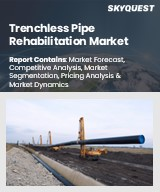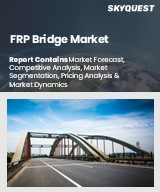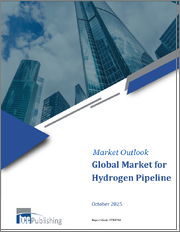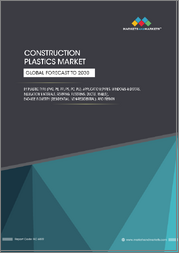
|
시장보고서
상품코드
1812131
CIPP(Cured-in-Place Pipe) 시장 : 세계 산업 규모, 점유율, 동향, 기회, 예측 - 수지 유형별, 경화 방법별, 용도별, 지역별, 경쟁별 부문(2020-2030F)Cured-in-Place Pipe Market - Global Industry Size, Share, Trends, Opportunity, and Forecast, Segmented By Resin Type, By Curing Method, By Application, By Region, and By Competition, 2020-2030F |
||||||
세계의 CIPP(Cured-in-Place Pipe) 시장 규모는 2024년에 29억 1,000만 달러, 예측 기간 중 CAGR은 4.82%로 2030년에는 38억 9,000만 달러에 달할 것으로 예측됩니다.
| 시장 개요 | |
|---|---|
| 예측 기간 | 2026-2030 |
| 시장 규모 : 2024년 | 29억 1,000만 달러 |
| 시장 규모 : 2030년 | 38억 9,000만 달러 |
| CAGR : 2025-2030년 | 4.82% |
| 급성장 부문 | 유리섬유 강화 폴리머 |
| 최대 시장 | 북미 |
인프라의 노후화, 도시화의 진전, 비용 효율적인 파이프라인 개조에 대한 수요 증가로 인해 세계 CIPP(CIPP) 시장은 강력한 성장세를 보이고 있습니다. CIPP는 굴착 없이 기존 파이프라인을 보수하는 트렌치리스 리빌딩(Trenchless Rehabilitation) 방식으로, 상하수도, 가스, 산업용 파이프라인의 수명을 연장하고자 하는 지자체, 유틸리티 사업자, 산업 사업자에게 선호되는 솔루션입니다. CIPP는 기존 굴착 및 교체 공법에 비해 환경 파괴 감소, 시공 시간 단축, 전체 비용 절감 등 큰 이점을 제공하며, 특히 인구 밀집도가 높은 도시 지역에서 인프라 업데이트의 효율성과 대중의 불편을 최소화하는 균형이 요구되는 상황에서 특히 매력적인 공법입니다. 이 시장을 지탱하는 것은 상하수도망 현대화를 위한 정부 투자이며, 특히 북미와 유럽은 수십 년이 지난 인프라로 인해 시급한 개보수가 필요한 상황입니다. 동시에 중국, 인도, 동남아시아의 도시들은 예산 및 환경적 제약과 함께 효율적인 파이프라인 시스템에 대한 수요 증가에 직면해 있습니다.
기술적 측면에서는 수지 화학, 라이너 재료, 경화 방법의 발전이 시장 역학을 재구성하고 있습니다. 폴리에스테르 수지는 비용 효율성으로 인해 여전히 가장 널리 사용되고 있지만, 더 높은 내화학성 및 내열성을 필요로 하는 용도에서는 비닐 에스테르와 에폭시가 점유율을 높이고 있습니다. 증기 경화는 입증된 성능과 비용 이점으로 시장을 독점하고 있지만, UV 경화는 가장 빠르게 성장하고 있는 분야로, 더 빠른 시공, 에너지 소비 감소, 내구성 향상, 고밀도 및 환경적으로 민감한 지역에서 점점 더 매력적으로 변하고 있습니다. 소구경 파이프, 특히 1피트 미만의 파이프는 주거 및 상업시설의 서비스 라인이 빈번한 개보수가 필요하므로 가장 큰 시장 점유율을 차지하고 있습니다. 한편, 지자체가 하수 본관 및 송수관로를 대상으로 하고 있으며, 대구경 설치도 꾸준히 증가하고 있습니다.
시장 성장 촉진요인
인프라 노후화 및 파이프라인 노후화
주요 시장 이슈
높은 초기 설치 비용과 재료비
주요 시장 동향
친환경 비스티렌계 수지에 대한 수요 증가
목차
제1장 개요
제2장 조사 방법
제3장 개요
제4장 고객의 소리
제5장 세계의 CIPP(Cured-in-Place Pipe) 시장 전망
- 시장 규모·예측
- 금액별
- 시장 점유율·예측
- 수지의 유형별(폴리에스테르, 유리섬유 강화 폴리머, 기타)
- 경화 방법별(증기 경화, UV 경화, 기타)
- 용도별(수도관·하수도관, 가스관, 산업용 배관, 기타)
- 지역별(북미, 유럽, 남미, 중동 및 아프리카, 아시아태평양)
- 기업별(2024)
- 시장 맵
제6장 북미의 CIPP(Cured-in-Place Pipe) 시장 전망
- 시장 규모·예측
- 시장 점유율·예측
- 북미 : 국가별 분석
- 미국
- 캐나다
- 멕시코
제7장 유럽의 CIPP(Cured-in-Place Pipe) 시장 전망
- 시장 규모·예측
- 시장 점유율·예측
- 유럽 : 국가별 분석
- 독일
- 프랑스
- 영국
- 이탈리아
- 스페인
제8장 아시아태평양의 CIPP(Cured-in-Place Pipe) 시장 전망
- 시장 규모·예측
- 시장 점유율·예측
- 아시아태평양 : 국가별 분석
- 중국
- 인도
- 일본
- 한국
- 호주
제9장 중동 및 아프리카의 CIPP(Cured-in-Place Pipe) 시장 전망
- 시장 규모·예측
- 시장 점유율·예측
- 중동 및 아프리카 : 국가별 분석
- 사우디아라비아
- 아랍에미리트
- 남아프리카공화국
제10장 남미의 CIPP(Cured-in-Place Pipe) 시장 전망
- 시장 규모·예측
- 시장 점유율·예측
- 남미 : 국가별 분석
- 브라질
- 콜롬비아
- 아르헨티나
제11장 시장 역학
- 촉진요인
- 과제
제12장 시장 동향과 발전
- 합병과 인수
- 제품 출시
- 최근 동향
제13장 기업 개요
- Aegion
- Granite Construction
- Inland Pipe Rehabilitation
- SAK Construction
- Michels Corporation
- PURIS Corporation
- Per Aarsleff A/S
- Reline UV Group
- SAERTEX multiCom GmbH
- IMPREG Group
제14장 전략적 제안
제15장 조사회사 소개·면책사항
KSA 25.09.23The Global Cured-in-Place Pipe Market was valued at USD 2.91 Billion in 2024 and is expected to reach USD 3.89 Billion by 2030 with a CAGR of 4.82% during the forecast period.
| Market Overview | |
|---|---|
| Forecast Period | 2026-2030 |
| Market Size 2024 | USD 2.91 Billion |
| Market Size 2030 | USD 3.89 Billion |
| CAGR 2025-2030 | 4.82% |
| Fastest Growing Segment | Glass Fiber Reinforced Polymer |
| Largest Market | North America |
The global Cured-in-Place Pipe (CIPP) market is witnessing strong growth momentum as aging infrastructure, rising urbanization, and increasing demand for cost-effective pipeline rehabilitation continue to drive adoption worldwide. CIPP, a trenchless rehabilitation method used to repair existing pipelines without excavation, has become a preferred solution for municipalities, utilities, and industrial operators seeking to extend the life of water, sewer, gas, and industrial pipelines. Compared to traditional dig-and-replace methods, CIPP offers significant advantages including reduced environmental disruption, faster installation times, and lower overall costs, making it particularly attractive for densely populated urban regions where infrastructure renewal must balance efficiency with minimal public inconvenience. The market is supported by government investments in modernizing water and wastewater networks, especially in North America and Europe, where infrastructure is decades old and requires urgent rehabilitation. At the same time, rapid urbanization and industrial expansion in Asia-Pacific are driving new opportunities, as cities in China, India, and Southeast Asia face rising demand for efficient pipeline systems coupled with budgetary and environmental constraints.
From a technology perspective, advancements in resin chemistry, liner materials, and curing methods are reshaping market dynamics. Polyester resins remain the most widely used due to their cost-effectiveness, but vinyl ester and epoxy are gaining share in applications requiring higher chemical and temperature resistance. Steam curing dominates the market thanks to its proven performance and cost benefits, while UV curing is the fastest-growing segment, offering faster installation, lower energy use, and enhanced durability, making it increasingly attractive in high-density and environmentally sensitive areas. Small-diameter pipes, especially those under one foot, hold the largest market share as residential and commercial service lines frequently require rehabilitation. Meanwhile, large-diameter installations are also growing steadily as municipalities target sewer mains and water transmission pipelines.
Key Market Drivers
Aging Infrastructure & Pipeline Deterioration
One of the strongest market drivers for CIPP is the extensive aging infrastructure across the globe. In North America alone, more than 2.2 million miles of pipelines are in need of rehabilitation, many of which are beyond their intended lifespan. Studies show that 42% of municipal pipelines are over 50 years old, placing them at high risk of leaks, blockages, and breaks. In the United States, drinking water systems have been rated C- while wastewater systems have been rated D+, underscoring the critical condition of the underground network. Aging infrastructure is not limited to the U.S.-many European cities face similar challenges, with more than 35% of sewer systems exceeding 40 years of service life. Municipalities are increasingly adopting trenchless technologies, and about 39% of utility providers already use CIPP methods for at least part of their rehabilitation programs. Case projects demonstrate the impact: in Texas, for example, over 30,000 feet of cast-iron water mains were rehabilitated using trenchless methods, saving over USD5 million compared to open-cut replacement. These figures highlight how widespread deterioration of water, sewer, and industrial pipelines is fueling consistent global demand for CIPP as a cost-effective and less disruptive rehabilitation solution.
Key Market Challenges
High Initial Installation and Material Costs
One of the foremost challenges in the global CIPP market is the relatively high upfront cost of installation compared to traditional dig-and-replace methods. The specialized equipment, resins, and liners required for CIPP rehabilitation projects demand significant investment, making it less accessible for municipalities with limited budgets. For instance, epoxy and polyester resin prices have risen by more than 20% in recent years due to raw material supply fluctuations, directly impacting project costs. Additionally, the cost of advanced UV curing systems can exceed several hundred thousand dollars, creating barriers for small contractors. Labor is another factor, as trained technicians who can handle trenchless rehabilitation demand premium wages. Furthermore, transportation of liners and resin-impregnated materials requires controlled conditions, adding logistics expenses. While the method reduces long-term costs by minimizing excavation and restoration, the upfront financial burden discourages adoption in cost-sensitive regions. This creates a market barrier, particularly in developing countries where infrastructure rehabilitation is needed most but budgets are constrained. The long-term cost-benefit often fails to outweigh the short-term expenditure from a procurement standpoint, slowing market penetration.
Key Market Trends
Rising Demand for Eco-Friendly and Non-Styrene Resins
Sustainability concerns are driving a notable trend toward eco-friendly resins in CIPP applications. Traditional styrene-based resins are being replaced with non-styrene alternatives such as vinyl ester, silicate, and epoxy systems, which release significantly fewer VOCs during curing. For instance, non-styrene resins can cut VOC emissions by up to 90%, addressing environmental regulations and community concerns. Additionally, epoxy-based liners provide superior mechanical strength and chemical resistance, extending service life to more than 50 years in some applications. Though these alternatives are more expensive, municipalities are increasingly willing to invest in sustainable solutions to meet climate targets. The adoption of green resins is also supported by certification programs that recognize environmentally friendly construction practices. Demand for sustainable CIPP solutions is particularly high in Europe, where regulatory frameworks such as REACH and the EU Green Deal encourage the use of safer materials. This shift toward eco-friendly resins not only mitigates regulatory risks but also enhances public acceptance of trenchless rehabilitation technologies, positioning them as sustainable infrastructure solutions.
Key Market Players
- Aegion
- Granite Construction
- Inland Pipe Rehabilitation
- SAK Construction
- Michels Corporation
- PURIS Corporation
- Per Aarsleff A/S
- Reline UV Group
- SAERTEX multiCom GmbH
- IMPREG Group
Report Scope:
In this report, the Global Cured-in-Place Pipe Market has been segmented into the following categories, in addition to the industry trends which have also been detailed below:
Cured-in-Place Pipe Market, By Resin Type:
- Polyester
- Glass Fiber Reinforced Polymer
- Others
Cured-in-Place Pipe Market, By Curing Method:
- Steam Curing
- UV Curing
- Others
Cured-in-Place Pipe Market, By Application:
- Water & Sewer Lines
- Gas Pipelines
- Industrial Piping
- Others
Cured-in-Place Pipe Market, By Region:
- North America
- United States
- Canada
- Mexico
- Europe
- Germany
- France
- United Kingdom
- Italy
- Spain
- South America
- Brazil
- Argentina
- Colombia
- Asia-Pacific
- China
- India
- Japan
- South Korea
- Australia
- Middle East & Africa
- Saudi Arabia
- UAE
- South Africa
Competitive Landscape
Company Profiles: Detailed analysis of the major companies present in the Global Cured-in-Place Pipe Market.
Available Customizations:
Global Cured-in-Place Pipe Market report with the given market data, Tech Sci Research offers customizations according to a company's specific needs. The following customization options are available for the report:
Company Information
- Detailed analysis and profiling of additional market players (up to five).
Table of Contents
1. Product Overview
- 1.1. Market Definition
- 1.2. Scope of the Market
- 1.2.1. Markets Covered
- 1.2.2. Years Considered for Study
- 1.2.3. Key Market Segmentations
2. Research Methodology
- 2.1. Objective of the Study
- 2.2. Baseline Methodology
- 2.3. Key Industry Partners
- 2.4. Major Association and Secondary Sources
- 2.5. Forecasting Methodology
- 2.6. Data Triangulation & Validation
- 2.7. Assumptions and Limitations
3. Executive Summary
- 3.1. Overview of the Market
- 3.2. Overview of Key Market Segmentations
- 3.3. Overview of Key Market Players
- 3.4. Overview of Key Regions/Countries
- 3.5. Overview of Market Drivers, Challenges, and Trends
4. Voice of Customer
5. Global Cured-in-Place Pipe Market Outlook
- 5.1. Market Size & Forecast
- 5.1.1. By Value
- 5.2. Market Share & Forecast
- 5.2.1. By Resin Type (Polyester, Glass Fiber Reinforced Polymer, Others)
- 5.2.2. By Curing Method (Steam Curing, UV Curing, Others)
- 5.2.3. By Application (Water & Sewer Lines, Gas Pipelines, Industrial Piping, Others)
- 5.2.4. By Region (North America, Europe, South America, Middle East & Africa, Asia Pacific)
- 5.3. By Company (2024)
- 5.4. Market Map
6. North America Cured-in-Place Pipe Market Outlook
- 6.1. Market Size & Forecast
- 6.1.1. By Value
- 6.2. Market Share & Forecast
- 6.2.1. By Resin Type
- 6.2.2. By Curing Method
- 6.2.3. By Application
- 6.2.4. By Country
- 6.3. North America: Country Analysis
- 6.3.1. United States Cured-in-Place Pipe Market Outlook
- 6.3.1.1. Market Size & Forecast
- 6.3.1.1.1. By Value
- 6.3.1.2. Market Share & Forecast
- 6.3.1.2.1. By Resin Type
- 6.3.1.2.2. By Curing Method
- 6.3.1.2.3. By Application
- 6.3.1.1. Market Size & Forecast
- 6.3.2. Canada Cured-in-Place Pipe Market Outlook
- 6.3.2.1. Market Size & Forecast
- 6.3.2.1.1. By Value
- 6.3.2.2. Market Share & Forecast
- 6.3.2.2.1. By Resin Type
- 6.3.2.2.2. By Curing Method
- 6.3.2.2.3. By Application
- 6.3.2.1. Market Size & Forecast
- 6.3.3. Mexico Cured-in-Place Pipe Market Outlook
- 6.3.3.1. Market Size & Forecast
- 6.3.3.1.1. By Value
- 6.3.3.2. Market Share & Forecast
- 6.3.3.2.1. By Resin Type
- 6.3.3.2.2. By Curing Method
- 6.3.3.2.3. By Application
- 6.3.3.1. Market Size & Forecast
- 6.3.1. United States Cured-in-Place Pipe Market Outlook
7. Europe Cured-in-Place Pipe Market Outlook
- 7.1. Market Size & Forecast
- 7.1.1. By Value
- 7.2. Market Share & Forecast
- 7.2.1. By Resin Type
- 7.2.2. By Curing Method
- 7.2.3. By Application
- 7.2.4. By Country
- 7.3. Europe: Country Analysis
- 7.3.1. Germany Cured-in-Place Pipe Market Outlook
- 7.3.1.1. Market Size & Forecast
- 7.3.1.1.1. By Value
- 7.3.1.2. Market Share & Forecast
- 7.3.1.2.1. By Resin Type
- 7.3.1.2.2. By Curing Method
- 7.3.1.2.3. By Application
- 7.3.1.1. Market Size & Forecast
- 7.3.2. France Cured-in-Place Pipe Market Outlook
- 7.3.2.1. Market Size & Forecast
- 7.3.2.1.1. By Value
- 7.3.2.2. Market Share & Forecast
- 7.3.2.2.1. By Resin Type
- 7.3.2.2.2. By Curing Method
- 7.3.2.2.3. By Application
- 7.3.2.1. Market Size & Forecast
- 7.3.3. United Kingdom Cured-in-Place Pipe Market Outlook
- 7.3.3.1. Market Size & Forecast
- 7.3.3.1.1. By Value
- 7.3.3.2. Market Share & Forecast
- 7.3.3.2.1. By Resin Type
- 7.3.3.2.2. By Curing Method
- 7.3.3.2.3. By Application
- 7.3.3.1. Market Size & Forecast
- 7.3.4. Italy Cured-in-Place Pipe Market Outlook
- 7.3.4.1. Market Size & Forecast
- 7.3.4.1.1. By Value
- 7.3.4.2. Market Share & Forecast
- 7.3.4.2.1. By Resin Type
- 7.3.4.2.2. By Curing Method
- 7.3.4.2.3. By Application
- 7.3.4.1. Market Size & Forecast
- 7.3.5. Spain Cured-in-Place Pipe Market Outlook
- 7.3.5.1. Market Size & Forecast
- 7.3.5.1.1. By Value
- 7.3.5.2. Market Share & Forecast
- 7.3.5.2.1. By Resin Type
- 7.3.5.2.2. By Curing Method
- 7.3.5.2.3. By Application
- 7.3.5.1. Market Size & Forecast
- 7.3.1. Germany Cured-in-Place Pipe Market Outlook
8. Asia Pacific Cured-in-Place Pipe Market Outlook
- 8.1. Market Size & Forecast
- 8.1.1. By Value
- 8.2. Market Share & Forecast
- 8.2.1. By Resin Type
- 8.2.2. By Curing Method
- 8.2.3. By Application
- 8.2.4. By Country
- 8.3. Asia Pacific: Country Analysis
- 8.3.1. China Cured-in-Place Pipe Market Outlook
- 8.3.1.1. Market Size & Forecast
- 8.3.1.1.1. By Value
- 8.3.1.2. Market Share & Forecast
- 8.3.1.2.1. By Resin Type
- 8.3.1.2.2. By Curing Method
- 8.3.1.2.3. By Application
- 8.3.1.1. Market Size & Forecast
- 8.3.2. India Cured-in-Place Pipe Market Outlook
- 8.3.2.1. Market Size & Forecast
- 8.3.2.1.1. By Value
- 8.3.2.2. Market Share & Forecast
- 8.3.2.2.1. By Resin Type
- 8.3.2.2.2. By Curing Method
- 8.3.2.2.3. By Application
- 8.3.2.1. Market Size & Forecast
- 8.3.3. Japan Cured-in-Place Pipe Market Outlook
- 8.3.3.1. Market Size & Forecast
- 8.3.3.1.1. By Value
- 8.3.3.2. Market Share & Forecast
- 8.3.3.2.1. By Resin Type
- 8.3.3.2.2. By Curing Method
- 8.3.3.2.3. By Application
- 8.3.3.1. Market Size & Forecast
- 8.3.4. South Korea Cured-in-Place Pipe Market Outlook
- 8.3.4.1. Market Size & Forecast
- 8.3.4.1.1. By Value
- 8.3.4.2. Market Share & Forecast
- 8.3.4.2.1. By Resin Type
- 8.3.4.2.2. By Curing Method
- 8.3.4.2.3. By Application
- 8.3.4.1. Market Size & Forecast
- 8.3.5. Australia Cured-in-Place Pipe Market Outlook
- 8.3.5.1. Market Size & Forecast
- 8.3.5.1.1. By Value
- 8.3.5.2. Market Share & Forecast
- 8.3.5.2.1. By Resin Type
- 8.3.5.2.2. By Curing Method
- 8.3.5.2.3. By Application
- 8.3.5.1. Market Size & Forecast
- 8.3.1. China Cured-in-Place Pipe Market Outlook
9. Middle East & Africa Cured-in-Place Pipe Market Outlook
- 9.1. Market Size & Forecast
- 9.1.1. By Value
- 9.2. Market Share & Forecast
- 9.2.1. By Resin Type
- 9.2.2. By Curing Method
- 9.2.3. By Application
- 9.2.4. By Country
- 9.3. Middle East & Africa: Country Analysis
- 9.3.1. Saudi Arabia Cured-in-Place Pipe Market Outlook
- 9.3.1.1. Market Size & Forecast
- 9.3.1.1.1. By Value
- 9.3.1.2. Market Share & Forecast
- 9.3.1.2.1. By Resin Type
- 9.3.1.2.2. By Curing Method
- 9.3.1.2.3. By Application
- 9.3.1.1. Market Size & Forecast
- 9.3.2. UAE Cured-in-Place Pipe Market Outlook
- 9.3.2.1. Market Size & Forecast
- 9.3.2.1.1. By Value
- 9.3.2.2. Market Share & Forecast
- 9.3.2.2.1. By Resin Type
- 9.3.2.2.2. By Curing Method
- 9.3.2.2.3. By Application
- 9.3.2.1. Market Size & Forecast
- 9.3.3. South Africa Cured-in-Place Pipe Market Outlook
- 9.3.3.1. Market Size & Forecast
- 9.3.3.1.1. By Value
- 9.3.3.2. Market Share & Forecast
- 9.3.3.2.1. By Resin Type
- 9.3.3.2.2. By Curing Method
- 9.3.3.2.3. By Application
- 9.3.3.1. Market Size & Forecast
- 9.3.1. Saudi Arabia Cured-in-Place Pipe Market Outlook
10. South America Cured-in-Place Pipe Market Outlook
- 10.1. Market Size & Forecast
- 10.1.1. By Value
- 10.2. Market Share & Forecast
- 10.2.1. By Resin Type
- 10.2.2. By Curing Method
- 10.2.3. By Application
- 10.2.4. By Country
- 10.3. South America: Country Analysis
- 10.3.1. Brazil Cured-in-Place Pipe Market Outlook
- 10.3.1.1. Market Size & Forecast
- 10.3.1.1.1. By Value
- 10.3.1.2. Market Share & Forecast
- 10.3.1.2.1. By Resin Type
- 10.3.1.2.2. By Curing Method
- 10.3.1.2.3. By Application
- 10.3.1.1. Market Size & Forecast
- 10.3.2. Colombia Cured-in-Place Pipe Market Outlook
- 10.3.2.1. Market Size & Forecast
- 10.3.2.1.1. By Value
- 10.3.2.2. Market Share & Forecast
- 10.3.2.2.1. By Resin Type
- 10.3.2.2.2. By Curing Method
- 10.3.2.2.3. By Application
- 10.3.2.1. Market Size & Forecast
- 10.3.3. Argentina Cured-in-Place Pipe Market Outlook
- 10.3.3.1. Market Size & Forecast
- 10.3.3.1.1. By Value
- 10.3.3.2. Market Share & Forecast
- 10.3.3.2.1. By Resin Type
- 10.3.3.2.2. By Curing Method
- 10.3.3.2.3. By Application
- 10.3.3.1. Market Size & Forecast
- 10.3.1. Brazil Cured-in-Place Pipe Market Outlook
11. Market Dynamics
- 11.1. Drivers
- 11.2. Challenges
12. Market Trends and Developments
- 12.1. Merger & Acquisition (If Any)
- 12.2. Product Launches (If Any)
- 12.3. Recent Developments
13. Company Profiles
- 13.1. Aegion
- 13.1.1. Business Overview
- 13.1.2. Key Revenue and Financials
- 13.1.3. Recent Developments
- 13.1.4. Key Personnel
- 13.1.5. Key Product/Services Offered
- 13.2. Granite Construction
- 13.3. Inland Pipe Rehabilitation
- 13.4. SAK Construction
- 13.5. Michels Corporation
- 13.6. PURIS Corporation
- 13.7. Per Aarsleff A/S
- 13.8. Reline UV Group
- 13.9. SAERTEX multiCom GmbH
- 13.10. IMPREG Group
14. Strategic Recommendations
15. About Us & Disclaimer
(주말 및 공휴일 제외)


















